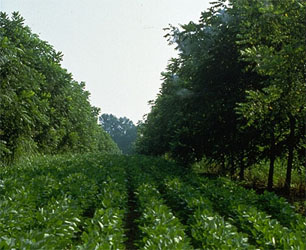“Mark Shepard, manager of New Forest Farms and author of the book Restoration Agriculture, will offer a critique of annual crop-based staple food production, while laying the ecological framework and reasons for designing a perennial staple food crops farm.
You will gain the basic skills to begin the transition from annuals to a permanent, perennial agriculture incorporating everything from nuts and berries, to livestock and fruits and vegetables.
Shepard’s talk will introduce the concept of ecosystem mimicry, Keyline water management and will help you to chart a path forward to a truly ecologically designed farm. This was presented by Mark Shepard at PV1 in March 2014.”
YouTube
Alleycropping & Silvopasture – Transitioning to Restoration Agriculture with Mark Shepard
Free ebook: Tree Crops: A permanent agriculture, by J. Russell Smith
Mark makes some very interesting points. He challenges annual grain farmers who have ideal topsoil to compete against his tree and shrub system grown on rocky wasteland. Mark believes he will win hands down because it’s so much more productive. Mark’s system is ideal for helping conventional farmers transition into more sustainable permaculture farms that combine trees with crops in between as in the photo below. Farms like these generate a profit every year and enhance biodiversity.

Image source: Association for Temperate Agroforestry

This is absolutely marvellous and I would like to carry out a similar program for an orphanage in East Sumba, Indonesia.
I’m in the process of developing this in my climate in my clay hills. It’s a long process, but it starts paying off relatively quickly. The key is species selection, and if you can build a system around natives and/or hardy species, your long-term payoff is even better.
Mark’s farm was heavily eroded red clay soil when they first bought it. Now after 15 years it’s a permaculture paradise with abundant wildlife, including lots of migrating birds that eat the insect pests. Mark’s family is now making and selling value added products like chocolate covered hazelnuts and apple cider.